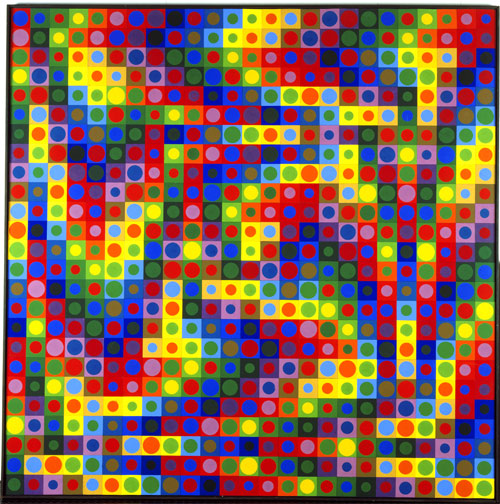VICTOR VASARELY – LAHUMIERE
17 rue du Parc Royal, 75003 Paris
In 1988, for our last Vasarely exhibition, Werner Spies wrote in our forword… It would suffice, and the time is ready, to have a critical retrospective of his work. Without a doubt, a glance at the extraordinary paintings of the Denfert, Belle-Ile and Gordes-Cristal periods, the photographisms, the planetary folklore and the permutations, will bring us the Vasarely that we still need. Twenty three years passed and no parisian institution made up her mind to show his works. Therefore we decided to close the gap and present in our house on three floors extraordinary works from 1948 onwards, illustrating the five periods described by Werner Spies.
Victor Vasarely was born in Hungary in 1906 and died in Paris, 1997. He studied at Sandor Bortnyik’s Muhely (the Hungarian Bauhaus), where he learned to find ways to “go beyond painting” via the geometric-abstract trend that the Bauhaus adapted to every field of art.
From a black-and-white period that lasted into the 1960s, Vasarely moved into a kinetic art also known as “optical art,” or Op Art. Works such as Bellatrix (1957) pointed in this direction: by a slight shift and vertical cut in circles he managed to create a certain optical illusion. The works Belle-Ile Meaux and Tampico, inspired by the island of Belle-Ile in Brittany, testify to his avowed efforts to render visible certain deformations based on pebbles on the beach.
By the early 1960s Vasarely was developing his own visual alphabet, which he also dubbed “planetary folklore.” This alphabet, inspired by Herbin (see his rough notes of 1973) enabled Vasarely to decompose an image into multiple, regular geometric pieces, called “visual units.” Each piece of this puzzle could be lifted and inserted at another point in the composition. A series of multiples and sculptures were conceived using this approach, as were major architectural projects such as a university dormitory in Caracas and a teacher’s school in Essen, not to mention a huge fresco in Montparnasse station in Paris and various private applications.
The field of a painting was handled in an “all over” manner, right to edges, so that there were no longer any privileged zones; form and content, top and bottom, right and left all became interchangeable, as seen in Majus 1967/68. Earlier works had already been signed at the top and the bottom. With such compositions Vasarely sought to address all beholders as equal, rejecting the need for prior cultural knowledge; his works could be immediately grasped and understood.
The underlying wealth of Vasarely’s oeuvre became truly visible once he began working with color. He made spheres such as Cheyt-rond 1970 in which color above all suggested the third dimension to the viewer. Yet works from the Gestalt series – see Gestalt-Ville 1969 – also used color to reveal the possibility of reversibility, where form can be perceived and felt in a positive and/or negative mode.
In the years that followed, Vasarely tirelessly, significantly pursued his kinetic ideas. He served as a mentor to many artists of the younger generation, and his once disdained works now appeal to a new public.

